Essentials of Management: Luscious Landscape Case Study Report
VerifiedAdded on 2022/11/25
|16
|4152
|249
Report
AI Summary
This report examines the management practices of Luscious Landscape, analyzing the application of Fayol's functions of management, key management skills, and a SWOT analysis to assess the company's strengths, weaknesses, opportunities, and threats. It explores the strategic direction of the company using the Ansoff Matrix and provides recommendations for improvement. Furthermore, the report delves into Maslow's hierarchy of needs to address employee motivation and retention, alongside an analysis of the five-stage team development model to enhance team performance. The report highlights the importance of effective communication, decision-making, and leadership traits in driving organizational success, with references to relevant management theories and models. It offers insights into how to improve employee satisfaction, reduce turnover, and foster business growth through strategic planning and implementation.
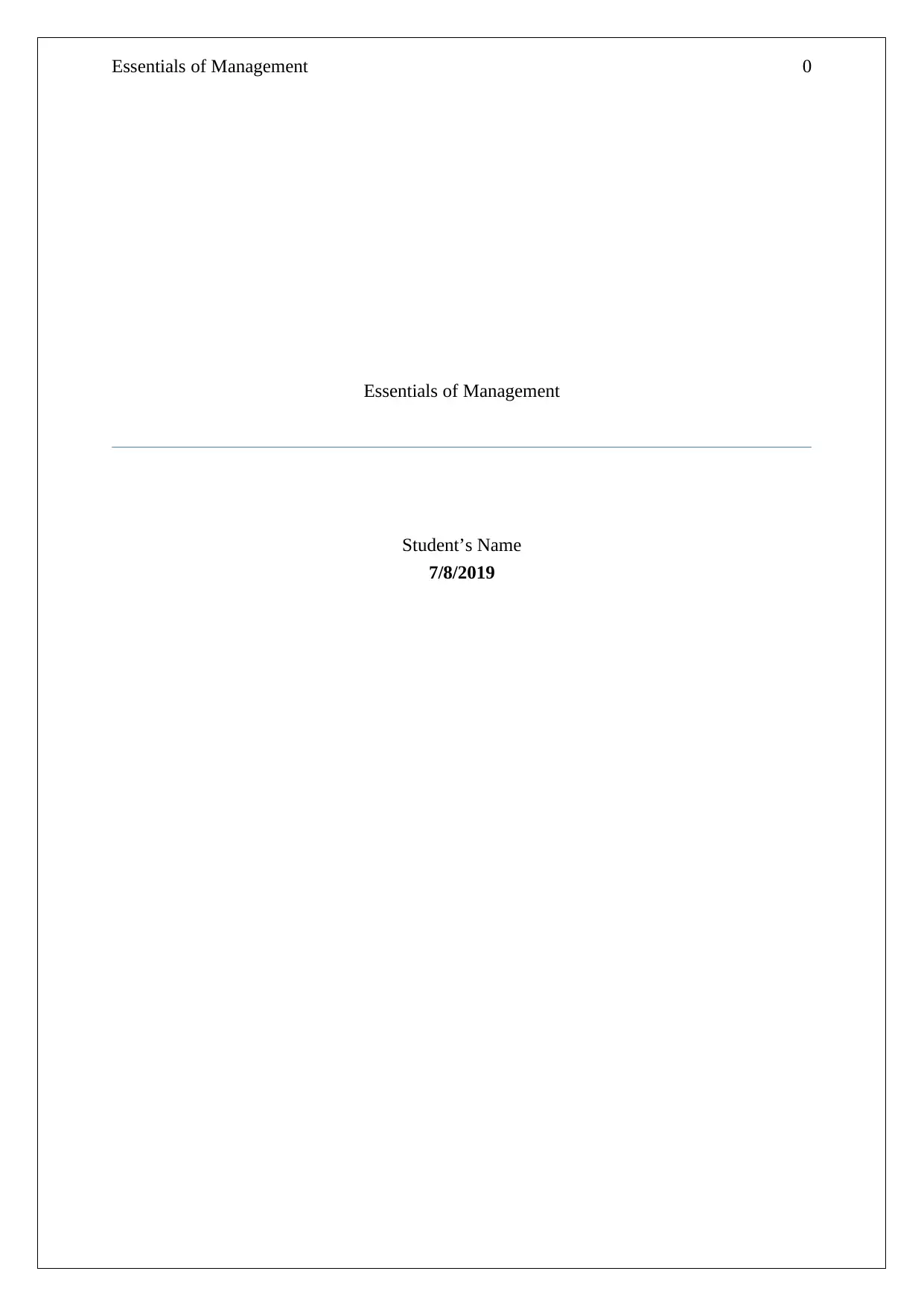
Essentials of Management 0
Essentials of Management
Student’s Name
7/8/2019
Essentials of Management
Student’s Name
7/8/2019
Paraphrase This Document
Need a fresh take? Get an instant paraphrase of this document with our AI Paraphraser
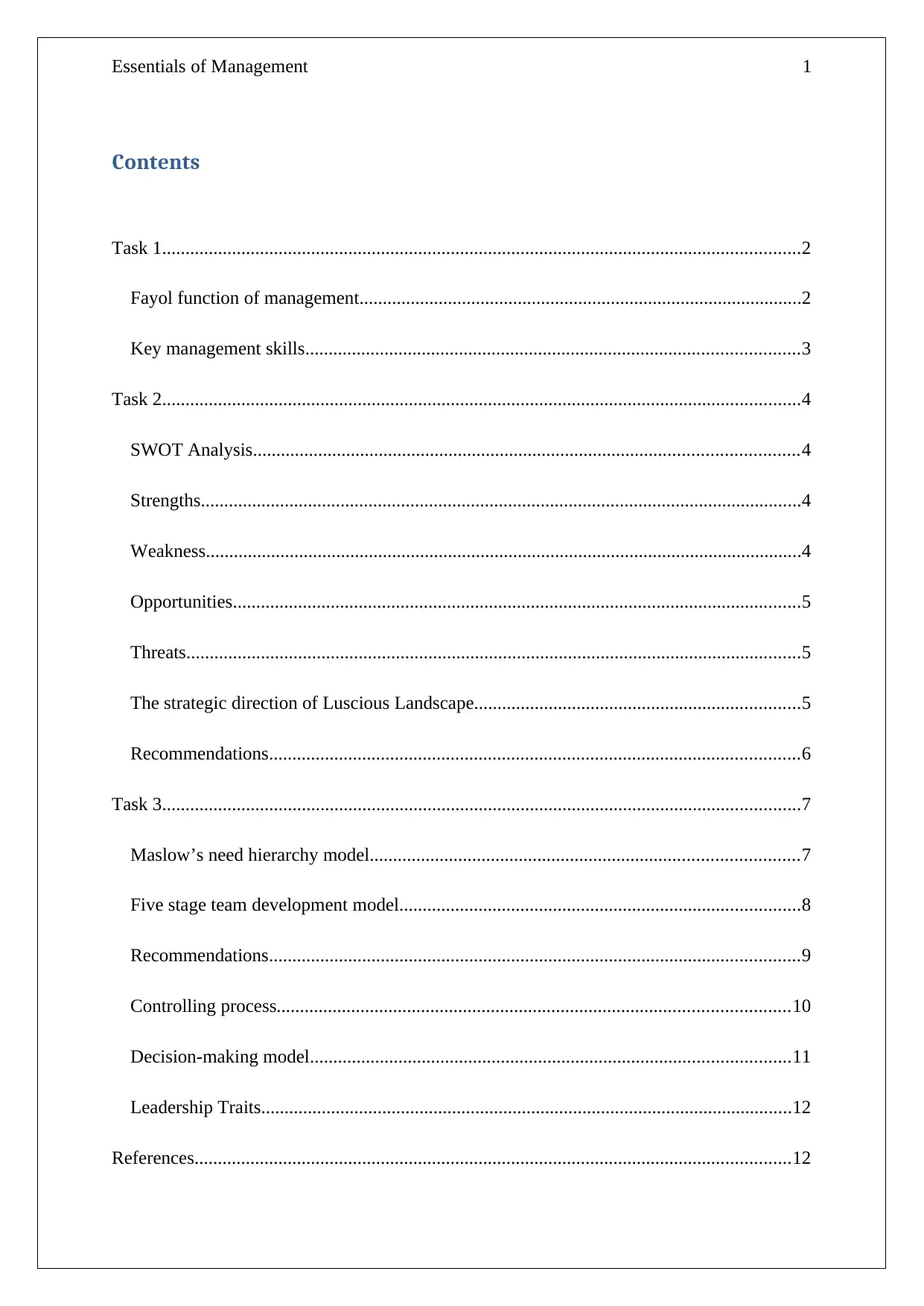
Essentials of Management 1
Contents
Task 1.........................................................................................................................................2
Fayol function of management...............................................................................................2
Key management skills..........................................................................................................3
Task 2.........................................................................................................................................4
SWOT Analysis.....................................................................................................................4
Strengths.................................................................................................................................4
Weakness................................................................................................................................4
Opportunities..........................................................................................................................5
Threats....................................................................................................................................5
The strategic direction of Luscious Landscape......................................................................5
Recommendations..................................................................................................................6
Task 3.........................................................................................................................................7
Maslow’s need hierarchy model............................................................................................7
Five stage team development model......................................................................................8
Recommendations..................................................................................................................9
Controlling process..............................................................................................................10
Decision-making model.......................................................................................................11
Leadership Traits..................................................................................................................12
References................................................................................................................................12
Contents
Task 1.........................................................................................................................................2
Fayol function of management...............................................................................................2
Key management skills..........................................................................................................3
Task 2.........................................................................................................................................4
SWOT Analysis.....................................................................................................................4
Strengths.................................................................................................................................4
Weakness................................................................................................................................4
Opportunities..........................................................................................................................5
Threats....................................................................................................................................5
The strategic direction of Luscious Landscape......................................................................5
Recommendations..................................................................................................................6
Task 3.........................................................................................................................................7
Maslow’s need hierarchy model............................................................................................7
Five stage team development model......................................................................................8
Recommendations..................................................................................................................9
Controlling process..............................................................................................................10
Decision-making model.......................................................................................................11
Leadership Traits..................................................................................................................12
References................................................................................................................................12
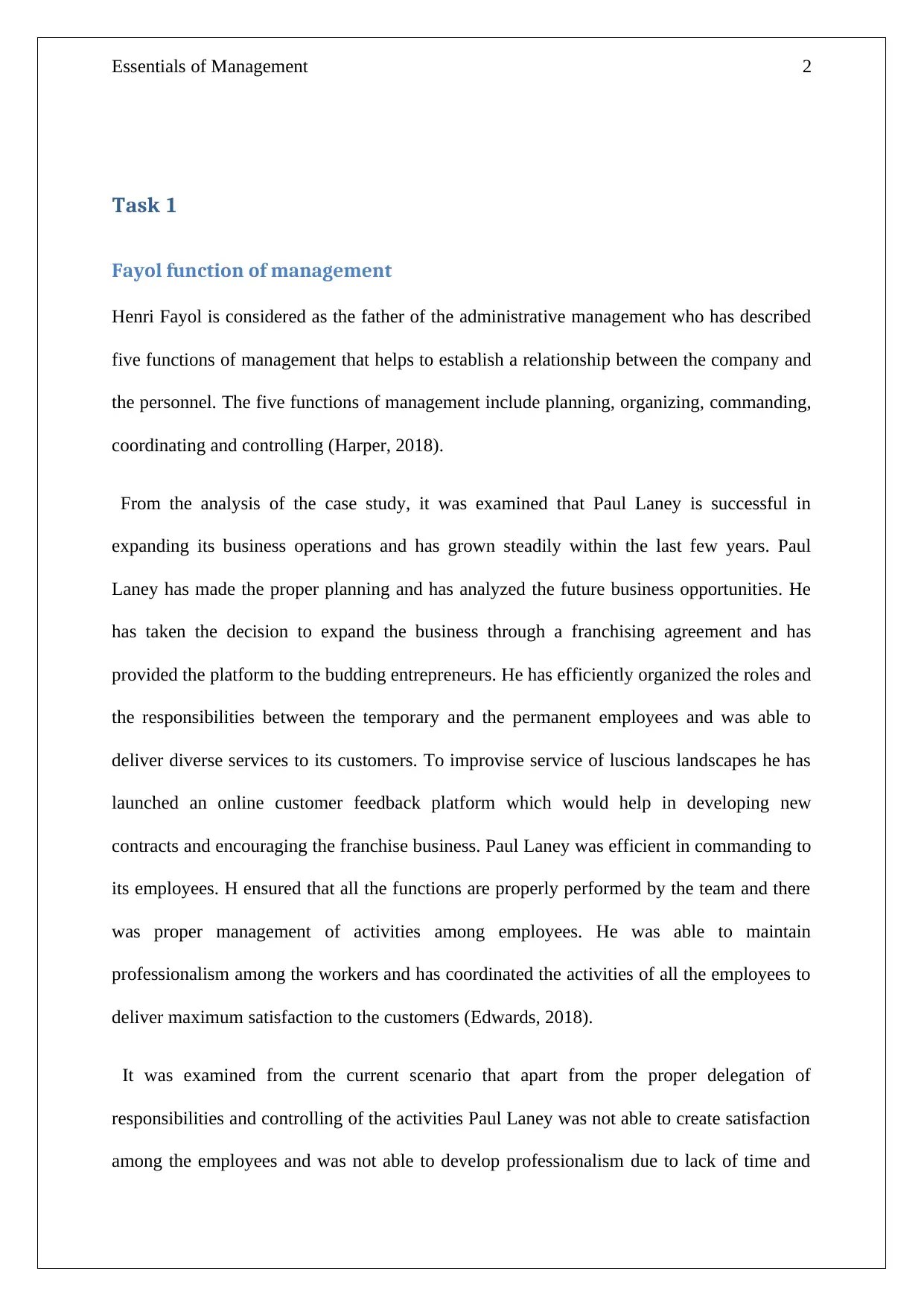
Essentials of Management 2
Task 1
Fayol function of management
Henri Fayol is considered as the father of the administrative management who has described
five functions of management that helps to establish a relationship between the company and
the personnel. The five functions of management include planning, organizing, commanding,
coordinating and controlling (Harper, 2018).
From the analysis of the case study, it was examined that Paul Laney is successful in
expanding its business operations and has grown steadily within the last few years. Paul
Laney has made the proper planning and has analyzed the future business opportunities. He
has taken the decision to expand the business through a franchising agreement and has
provided the platform to the budding entrepreneurs. He has efficiently organized the roles and
the responsibilities between the temporary and the permanent employees and was able to
deliver diverse services to its customers. To improvise service of luscious landscapes he has
launched an online customer feedback platform which would help in developing new
contracts and encouraging the franchise business. Paul Laney was efficient in commanding to
its employees. H ensured that all the functions are properly performed by the team and there
was proper management of activities among employees. He was able to maintain
professionalism among the workers and has coordinated the activities of all the employees to
deliver maximum satisfaction to the customers (Edwards, 2018).
It was examined from the current scenario that apart from the proper delegation of
responsibilities and controlling of the activities Paul Laney was not able to create satisfaction
among the employees and was not able to develop professionalism due to lack of time and
Task 1
Fayol function of management
Henri Fayol is considered as the father of the administrative management who has described
five functions of management that helps to establish a relationship between the company and
the personnel. The five functions of management include planning, organizing, commanding,
coordinating and controlling (Harper, 2018).
From the analysis of the case study, it was examined that Paul Laney is successful in
expanding its business operations and has grown steadily within the last few years. Paul
Laney has made the proper planning and has analyzed the future business opportunities. He
has taken the decision to expand the business through a franchising agreement and has
provided the platform to the budding entrepreneurs. He has efficiently organized the roles and
the responsibilities between the temporary and the permanent employees and was able to
deliver diverse services to its customers. To improvise service of luscious landscapes he has
launched an online customer feedback platform which would help in developing new
contracts and encouraging the franchise business. Paul Laney was efficient in commanding to
its employees. H ensured that all the functions are properly performed by the team and there
was proper management of activities among employees. He was able to maintain
professionalism among the workers and has coordinated the activities of all the employees to
deliver maximum satisfaction to the customers (Edwards, 2018).
It was examined from the current scenario that apart from the proper delegation of
responsibilities and controlling of the activities Paul Laney was not able to create satisfaction
among the employees and was not able to develop professionalism due to lack of time and
⊘ This is a preview!⊘
Do you want full access?
Subscribe today to unlock all pages.

Trusted by 1+ million students worldwide
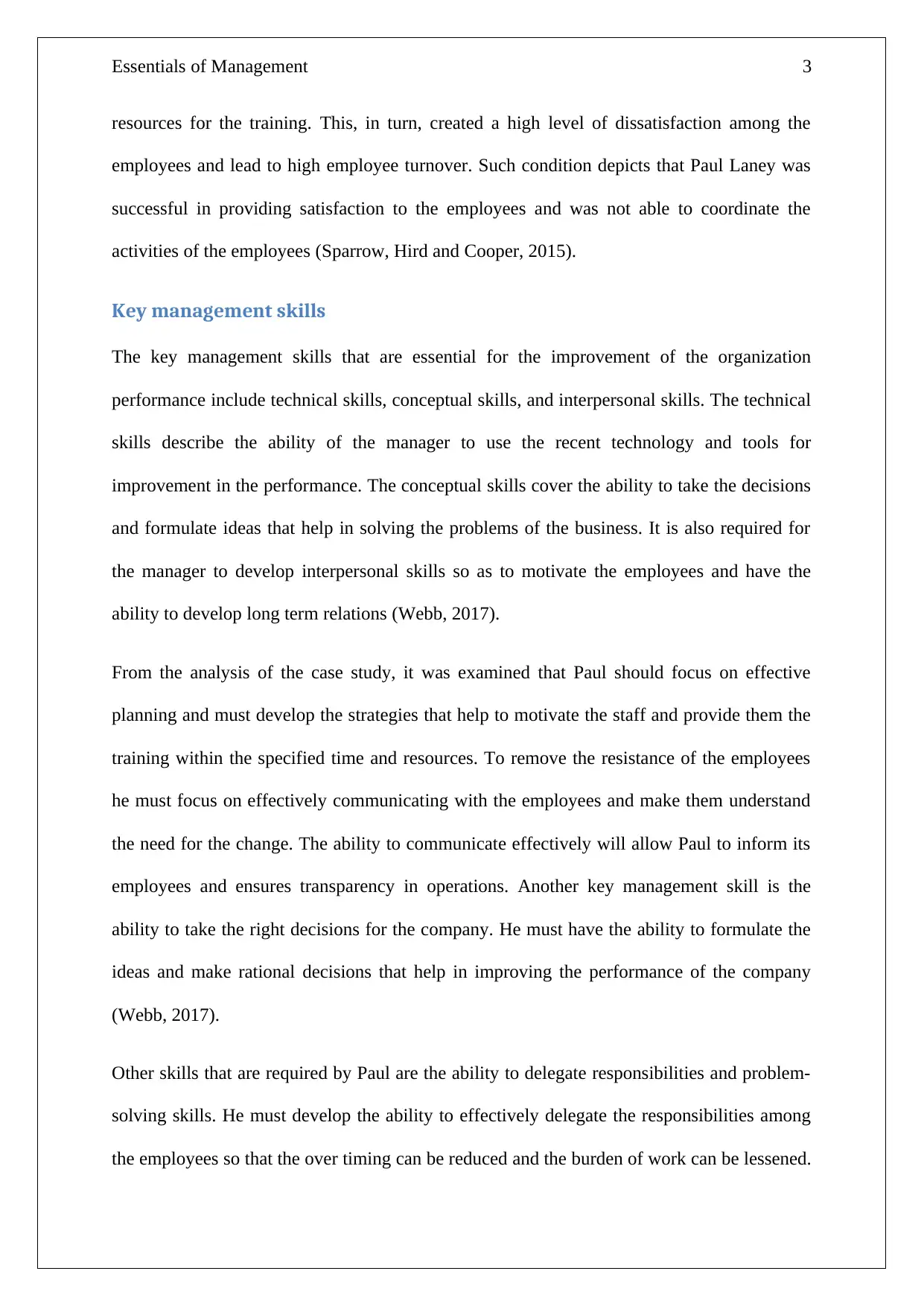
Essentials of Management 3
resources for the training. This, in turn, created a high level of dissatisfaction among the
employees and lead to high employee turnover. Such condition depicts that Paul Laney was
successful in providing satisfaction to the employees and was not able to coordinate the
activities of the employees (Sparrow, Hird and Cooper, 2015).
Key management skills
The key management skills that are essential for the improvement of the organization
performance include technical skills, conceptual skills, and interpersonal skills. The technical
skills describe the ability of the manager to use the recent technology and tools for
improvement in the performance. The conceptual skills cover the ability to take the decisions
and formulate ideas that help in solving the problems of the business. It is also required for
the manager to develop interpersonal skills so as to motivate the employees and have the
ability to develop long term relations (Webb, 2017).
From the analysis of the case study, it was examined that Paul should focus on effective
planning and must develop the strategies that help to motivate the staff and provide them the
training within the specified time and resources. To remove the resistance of the employees
he must focus on effectively communicating with the employees and make them understand
the need for the change. The ability to communicate effectively will allow Paul to inform its
employees and ensures transparency in operations. Another key management skill is the
ability to take the right decisions for the company. He must have the ability to formulate the
ideas and make rational decisions that help in improving the performance of the company
(Webb, 2017).
Other skills that are required by Paul are the ability to delegate responsibilities and problem-
solving skills. He must develop the ability to effectively delegate the responsibilities among
the employees so that the over timing can be reduced and the burden of work can be lessened.
resources for the training. This, in turn, created a high level of dissatisfaction among the
employees and lead to high employee turnover. Such condition depicts that Paul Laney was
successful in providing satisfaction to the employees and was not able to coordinate the
activities of the employees (Sparrow, Hird and Cooper, 2015).
Key management skills
The key management skills that are essential for the improvement of the organization
performance include technical skills, conceptual skills, and interpersonal skills. The technical
skills describe the ability of the manager to use the recent technology and tools for
improvement in the performance. The conceptual skills cover the ability to take the decisions
and formulate ideas that help in solving the problems of the business. It is also required for
the manager to develop interpersonal skills so as to motivate the employees and have the
ability to develop long term relations (Webb, 2017).
From the analysis of the case study, it was examined that Paul should focus on effective
planning and must develop the strategies that help to motivate the staff and provide them the
training within the specified time and resources. To remove the resistance of the employees
he must focus on effectively communicating with the employees and make them understand
the need for the change. The ability to communicate effectively will allow Paul to inform its
employees and ensures transparency in operations. Another key management skill is the
ability to take the right decisions for the company. He must have the ability to formulate the
ideas and make rational decisions that help in improving the performance of the company
(Webb, 2017).
Other skills that are required by Paul are the ability to delegate responsibilities and problem-
solving skills. He must develop the ability to effectively delegate the responsibilities among
the employees so that the over timing can be reduced and the burden of work can be lessened.
Paraphrase This Document
Need a fresh take? Get an instant paraphrase of this document with our AI Paraphraser
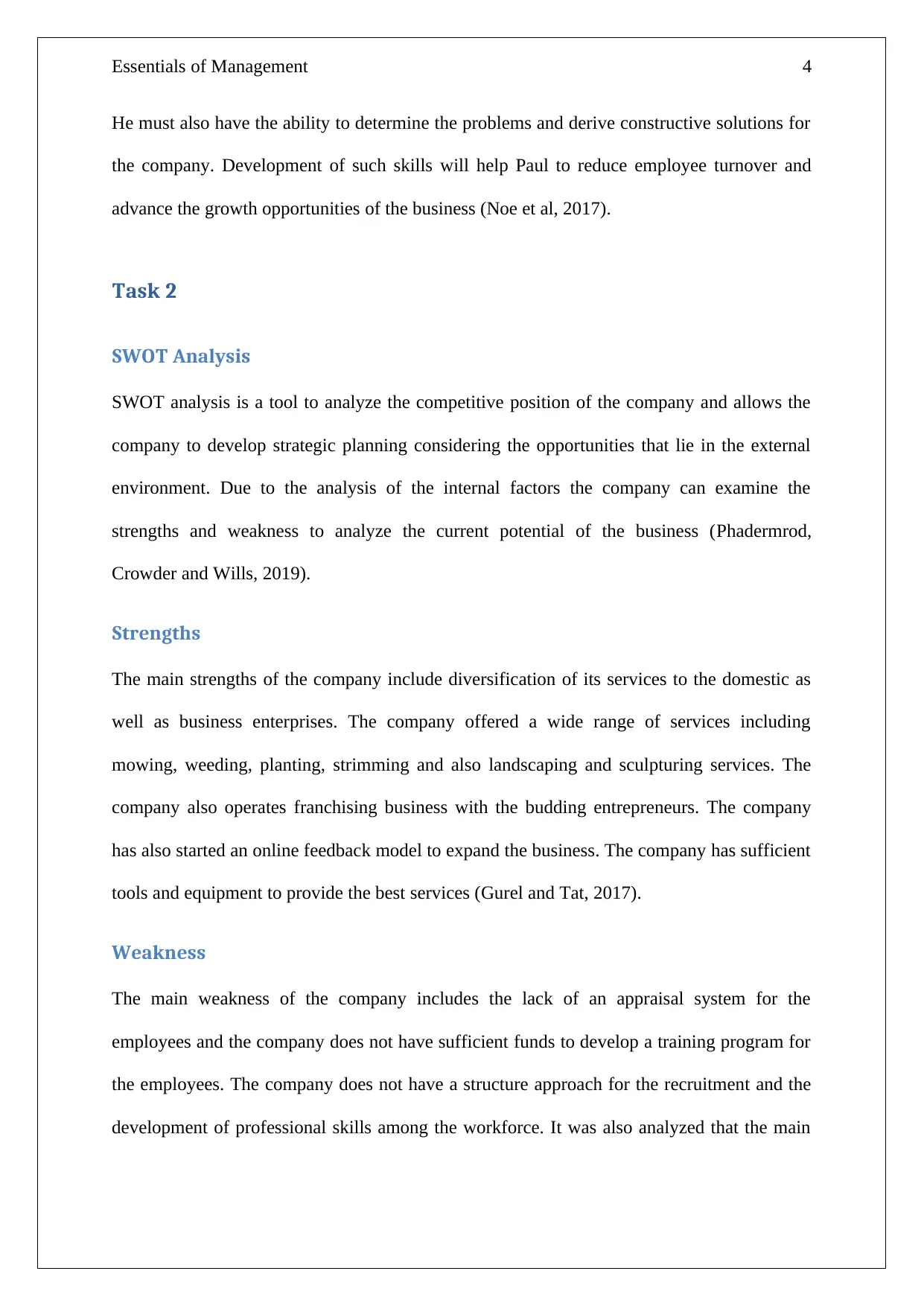
Essentials of Management 4
He must also have the ability to determine the problems and derive constructive solutions for
the company. Development of such skills will help Paul to reduce employee turnover and
advance the growth opportunities of the business (Noe et al, 2017).
Task 2
SWOT Analysis
SWOT analysis is a tool to analyze the competitive position of the company and allows the
company to develop strategic planning considering the opportunities that lie in the external
environment. Due to the analysis of the internal factors the company can examine the
strengths and weakness to analyze the current potential of the business (Phadermrod,
Crowder and Wills, 2019).
Strengths
The main strengths of the company include diversification of its services to the domestic as
well as business enterprises. The company offered a wide range of services including
mowing, weeding, planting, strimming and also landscaping and sculpturing services. The
company also operates franchising business with the budding entrepreneurs. The company
has also started an online feedback model to expand the business. The company has sufficient
tools and equipment to provide the best services (Gurel and Tat, 2017).
Weakness
The main weakness of the company includes the lack of an appraisal system for the
employees and the company does not have sufficient funds to develop a training program for
the employees. The company does not have a structure approach for the recruitment and the
development of professional skills among the workforce. It was also analyzed that the main
He must also have the ability to determine the problems and derive constructive solutions for
the company. Development of such skills will help Paul to reduce employee turnover and
advance the growth opportunities of the business (Noe et al, 2017).
Task 2
SWOT Analysis
SWOT analysis is a tool to analyze the competitive position of the company and allows the
company to develop strategic planning considering the opportunities that lie in the external
environment. Due to the analysis of the internal factors the company can examine the
strengths and weakness to analyze the current potential of the business (Phadermrod,
Crowder and Wills, 2019).
Strengths
The main strengths of the company include diversification of its services to the domestic as
well as business enterprises. The company offered a wide range of services including
mowing, weeding, planting, strimming and also landscaping and sculpturing services. The
company also operates franchising business with the budding entrepreneurs. The company
has also started an online feedback model to expand the business. The company has sufficient
tools and equipment to provide the best services (Gurel and Tat, 2017).
Weakness
The main weakness of the company includes the lack of an appraisal system for the
employees and the company does not have sufficient funds to develop a training program for
the employees. The company does not have a structure approach for the recruitment and the
development of professional skills among the workforce. It was also analyzed that the main
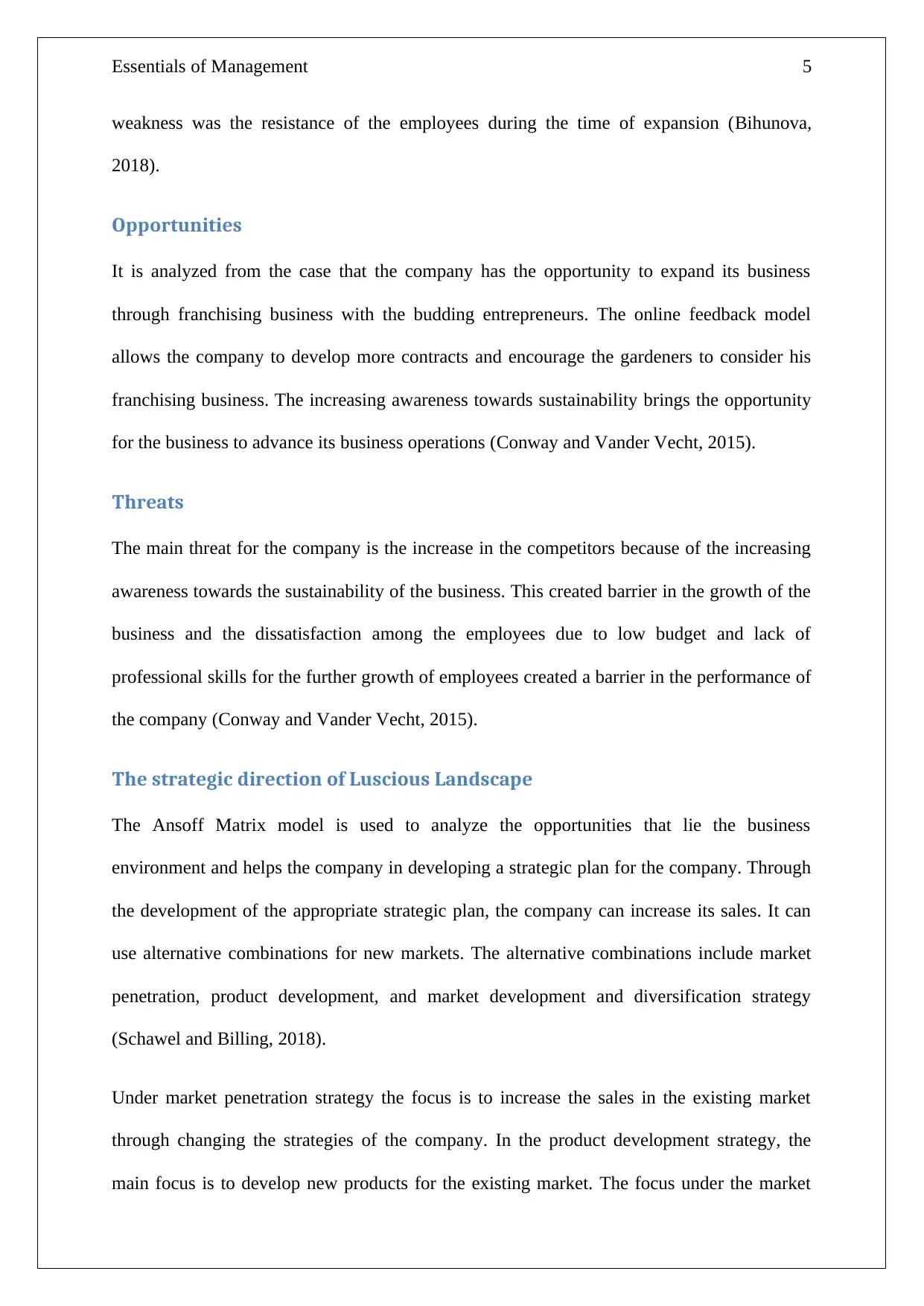
Essentials of Management 5
weakness was the resistance of the employees during the time of expansion (Bihunova,
2018).
Opportunities
It is analyzed from the case that the company has the opportunity to expand its business
through franchising business with the budding entrepreneurs. The online feedback model
allows the company to develop more contracts and encourage the gardeners to consider his
franchising business. The increasing awareness towards sustainability brings the opportunity
for the business to advance its business operations (Conway and Vander Vecht, 2015).
Threats
The main threat for the company is the increase in the competitors because of the increasing
awareness towards the sustainability of the business. This created barrier in the growth of the
business and the dissatisfaction among the employees due to low budget and lack of
professional skills for the further growth of employees created a barrier in the performance of
the company (Conway and Vander Vecht, 2015).
The strategic direction of Luscious Landscape
The Ansoff Matrix model is used to analyze the opportunities that lie the business
environment and helps the company in developing a strategic plan for the company. Through
the development of the appropriate strategic plan, the company can increase its sales. It can
use alternative combinations for new markets. The alternative combinations include market
penetration, product development, and market development and diversification strategy
(Schawel and Billing, 2018).
Under market penetration strategy the focus is to increase the sales in the existing market
through changing the strategies of the company. In the product development strategy, the
main focus is to develop new products for the existing market. The focus under the market
weakness was the resistance of the employees during the time of expansion (Bihunova,
2018).
Opportunities
It is analyzed from the case that the company has the opportunity to expand its business
through franchising business with the budding entrepreneurs. The online feedback model
allows the company to develop more contracts and encourage the gardeners to consider his
franchising business. The increasing awareness towards sustainability brings the opportunity
for the business to advance its business operations (Conway and Vander Vecht, 2015).
Threats
The main threat for the company is the increase in the competitors because of the increasing
awareness towards the sustainability of the business. This created barrier in the growth of the
business and the dissatisfaction among the employees due to low budget and lack of
professional skills for the further growth of employees created a barrier in the performance of
the company (Conway and Vander Vecht, 2015).
The strategic direction of Luscious Landscape
The Ansoff Matrix model is used to analyze the opportunities that lie the business
environment and helps the company in developing a strategic plan for the company. Through
the development of the appropriate strategic plan, the company can increase its sales. It can
use alternative combinations for new markets. The alternative combinations include market
penetration, product development, and market development and diversification strategy
(Schawel and Billing, 2018).
Under market penetration strategy the focus is to increase the sales in the existing market
through changing the strategies of the company. In the product development strategy, the
main focus is to develop new products for the existing market. The focus under the market
⊘ This is a preview!⊘
Do you want full access?
Subscribe today to unlock all pages.

Trusted by 1+ million students worldwide
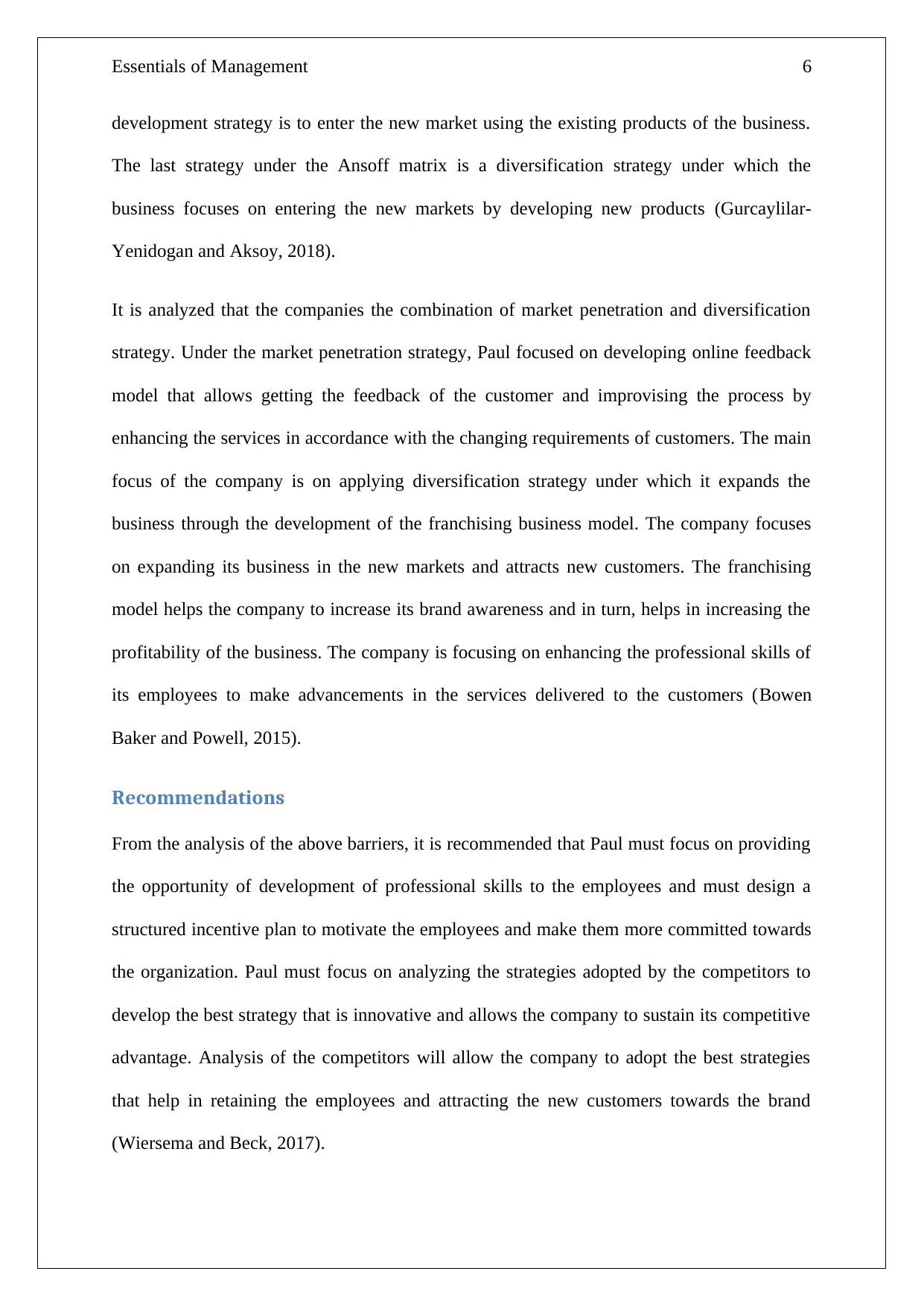
Essentials of Management 6
development strategy is to enter the new market using the existing products of the business.
The last strategy under the Ansoff matrix is a diversification strategy under which the
business focuses on entering the new markets by developing new products (Gurcaylilar-
Yenidogan and Aksoy, 2018).
It is analyzed that the companies the combination of market penetration and diversification
strategy. Under the market penetration strategy, Paul focused on developing online feedback
model that allows getting the feedback of the customer and improvising the process by
enhancing the services in accordance with the changing requirements of customers. The main
focus of the company is on applying diversification strategy under which it expands the
business through the development of the franchising business model. The company focuses
on expanding its business in the new markets and attracts new customers. The franchising
model helps the company to increase its brand awareness and in turn, helps in increasing the
profitability of the business. The company is focusing on enhancing the professional skills of
its employees to make advancements in the services delivered to the customers (Bowen
Baker and Powell, 2015).
Recommendations
From the analysis of the above barriers, it is recommended that Paul must focus on providing
the opportunity of development of professional skills to the employees and must design a
structured incentive plan to motivate the employees and make them more committed towards
the organization. Paul must focus on analyzing the strategies adopted by the competitors to
develop the best strategy that is innovative and allows the company to sustain its competitive
advantage. Analysis of the competitors will allow the company to adopt the best strategies
that help in retaining the employees and attracting the new customers towards the brand
(Wiersema and Beck, 2017).
development strategy is to enter the new market using the existing products of the business.
The last strategy under the Ansoff matrix is a diversification strategy under which the
business focuses on entering the new markets by developing new products (Gurcaylilar-
Yenidogan and Aksoy, 2018).
It is analyzed that the companies the combination of market penetration and diversification
strategy. Under the market penetration strategy, Paul focused on developing online feedback
model that allows getting the feedback of the customer and improvising the process by
enhancing the services in accordance with the changing requirements of customers. The main
focus of the company is on applying diversification strategy under which it expands the
business through the development of the franchising business model. The company focuses
on expanding its business in the new markets and attracts new customers. The franchising
model helps the company to increase its brand awareness and in turn, helps in increasing the
profitability of the business. The company is focusing on enhancing the professional skills of
its employees to make advancements in the services delivered to the customers (Bowen
Baker and Powell, 2015).
Recommendations
From the analysis of the above barriers, it is recommended that Paul must focus on providing
the opportunity of development of professional skills to the employees and must design a
structured incentive plan to motivate the employees and make them more committed towards
the organization. Paul must focus on analyzing the strategies adopted by the competitors to
develop the best strategy that is innovative and allows the company to sustain its competitive
advantage. Analysis of the competitors will allow the company to adopt the best strategies
that help in retaining the employees and attracting the new customers towards the brand
(Wiersema and Beck, 2017).
Paraphrase This Document
Need a fresh take? Get an instant paraphrase of this document with our AI Paraphraser
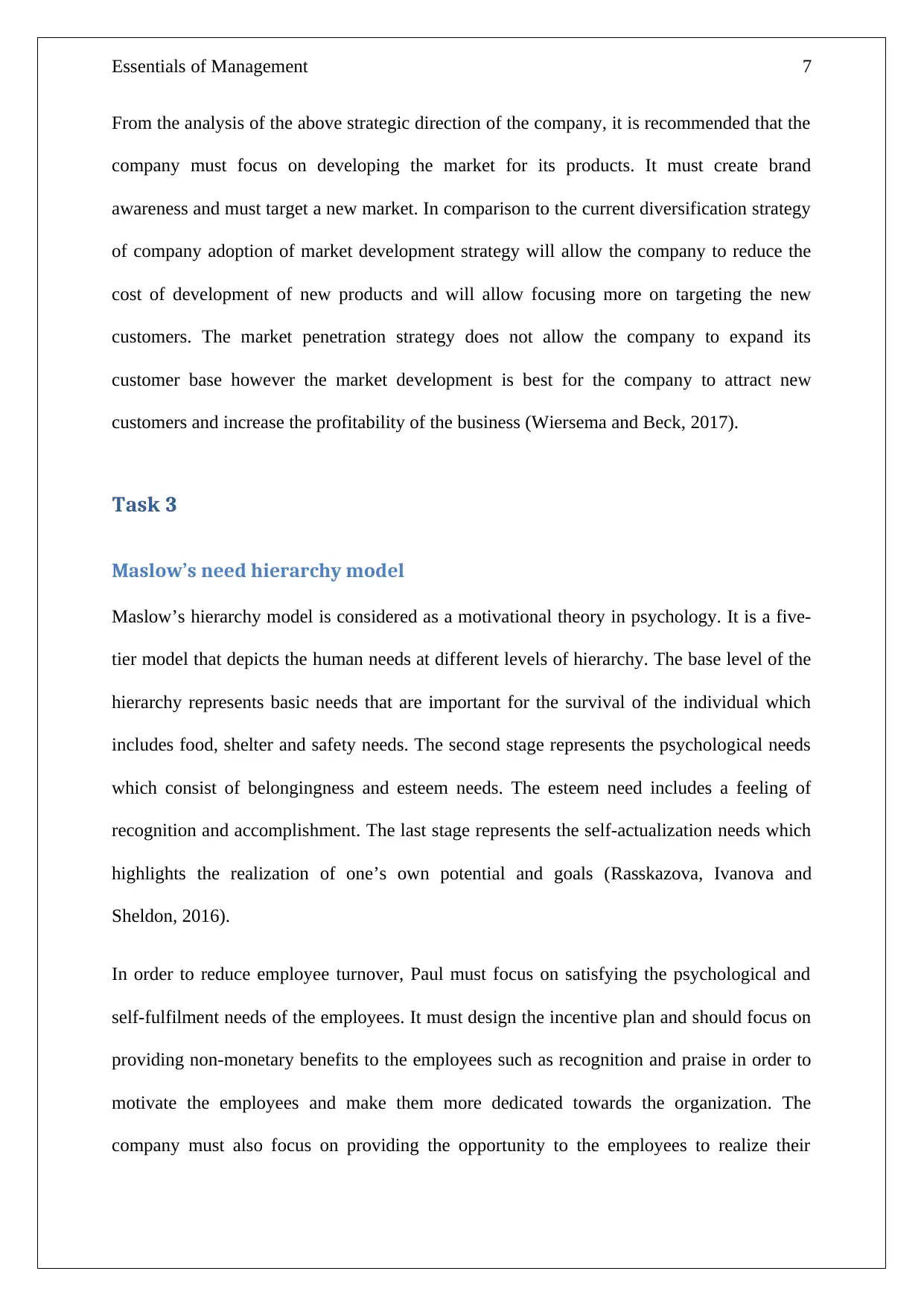
Essentials of Management 7
From the analysis of the above strategic direction of the company, it is recommended that the
company must focus on developing the market for its products. It must create brand
awareness and must target a new market. In comparison to the current diversification strategy
of company adoption of market development strategy will allow the company to reduce the
cost of development of new products and will allow focusing more on targeting the new
customers. The market penetration strategy does not allow the company to expand its
customer base however the market development is best for the company to attract new
customers and increase the profitability of the business (Wiersema and Beck, 2017).
Task 3
Maslow’s need hierarchy model
Maslow’s hierarchy model is considered as a motivational theory in psychology. It is a five-
tier model that depicts the human needs at different levels of hierarchy. The base level of the
hierarchy represents basic needs that are important for the survival of the individual which
includes food, shelter and safety needs. The second stage represents the psychological needs
which consist of belongingness and esteem needs. The esteem need includes a feeling of
recognition and accomplishment. The last stage represents the self-actualization needs which
highlights the realization of one’s own potential and goals (Rasskazova, Ivanova and
Sheldon, 2016).
In order to reduce employee turnover, Paul must focus on satisfying the psychological and
self-fulfilment needs of the employees. It must design the incentive plan and should focus on
providing non-monetary benefits to the employees such as recognition and praise in order to
motivate the employees and make them more dedicated towards the organization. The
company must also focus on providing the opportunity to the employees to realize their
From the analysis of the above strategic direction of the company, it is recommended that the
company must focus on developing the market for its products. It must create brand
awareness and must target a new market. In comparison to the current diversification strategy
of company adoption of market development strategy will allow the company to reduce the
cost of development of new products and will allow focusing more on targeting the new
customers. The market penetration strategy does not allow the company to expand its
customer base however the market development is best for the company to attract new
customers and increase the profitability of the business (Wiersema and Beck, 2017).
Task 3
Maslow’s need hierarchy model
Maslow’s hierarchy model is considered as a motivational theory in psychology. It is a five-
tier model that depicts the human needs at different levels of hierarchy. The base level of the
hierarchy represents basic needs that are important for the survival of the individual which
includes food, shelter and safety needs. The second stage represents the psychological needs
which consist of belongingness and esteem needs. The esteem need includes a feeling of
recognition and accomplishment. The last stage represents the self-actualization needs which
highlights the realization of one’s own potential and goals (Rasskazova, Ivanova and
Sheldon, 2016).
In order to reduce employee turnover, Paul must focus on satisfying the psychological and
self-fulfilment needs of the employees. It must design the incentive plan and should focus on
providing non-monetary benefits to the employees such as recognition and praise in order to
motivate the employees and make them more dedicated towards the organization. The
company must also focus on providing the opportunity to the employees to realize their
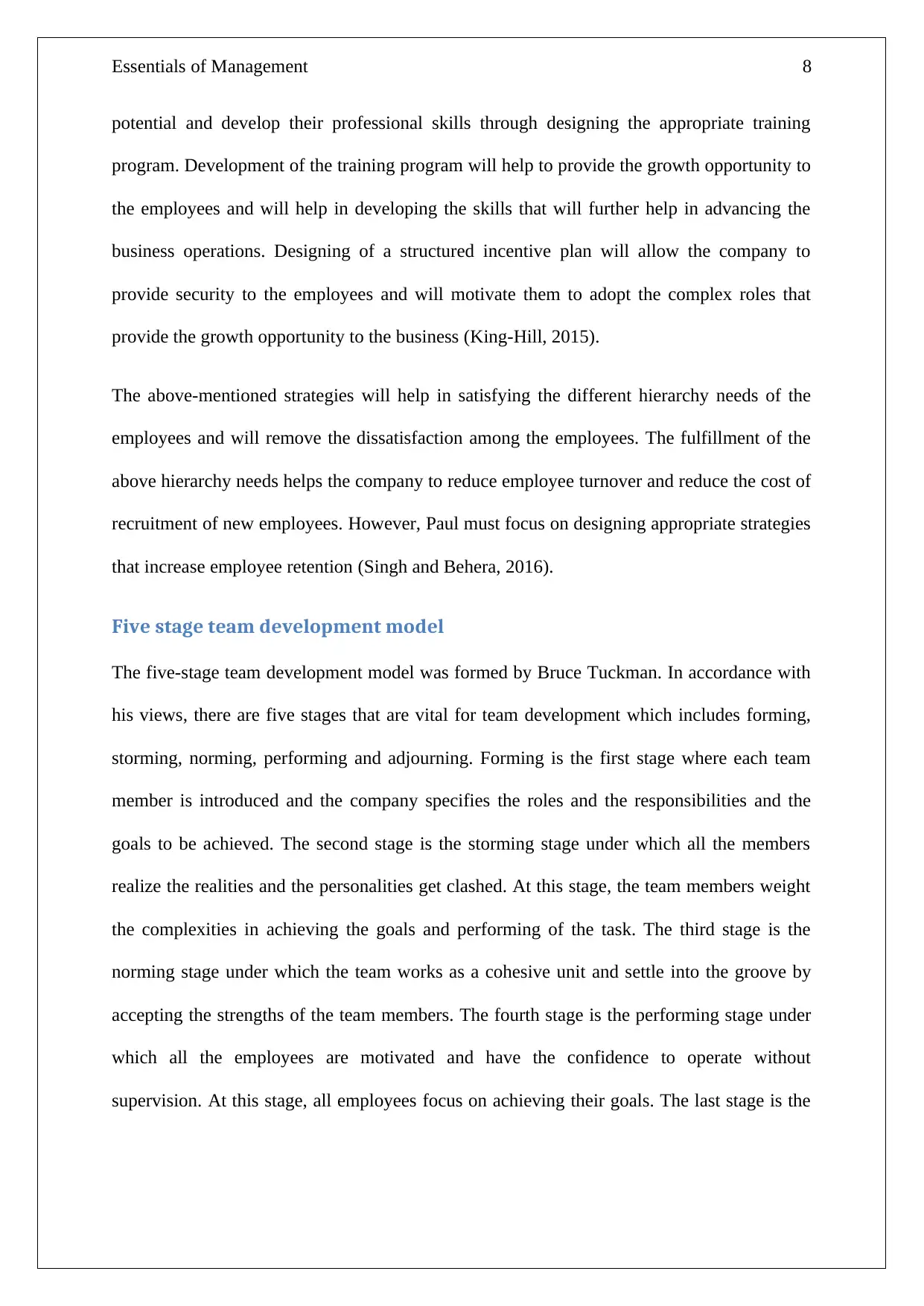
Essentials of Management 8
potential and develop their professional skills through designing the appropriate training
program. Development of the training program will help to provide the growth opportunity to
the employees and will help in developing the skills that will further help in advancing the
business operations. Designing of a structured incentive plan will allow the company to
provide security to the employees and will motivate them to adopt the complex roles that
provide the growth opportunity to the business (King-Hill, 2015).
The above-mentioned strategies will help in satisfying the different hierarchy needs of the
employees and will remove the dissatisfaction among the employees. The fulfillment of the
above hierarchy needs helps the company to reduce employee turnover and reduce the cost of
recruitment of new employees. However, Paul must focus on designing appropriate strategies
that increase employee retention (Singh and Behera, 2016).
Five stage team development model
The five-stage team development model was formed by Bruce Tuckman. In accordance with
his views, there are five stages that are vital for team development which includes forming,
storming, norming, performing and adjourning. Forming is the first stage where each team
member is introduced and the company specifies the roles and the responsibilities and the
goals to be achieved. The second stage is the storming stage under which all the members
realize the realities and the personalities get clashed. At this stage, the team members weight
the complexities in achieving the goals and performing of the task. The third stage is the
norming stage under which the team works as a cohesive unit and settle into the groove by
accepting the strengths of the team members. The fourth stage is the performing stage under
which all the employees are motivated and have the confidence to operate without
supervision. At this stage, all employees focus on achieving their goals. The last stage is the
potential and develop their professional skills through designing the appropriate training
program. Development of the training program will help to provide the growth opportunity to
the employees and will help in developing the skills that will further help in advancing the
business operations. Designing of a structured incentive plan will allow the company to
provide security to the employees and will motivate them to adopt the complex roles that
provide the growth opportunity to the business (King-Hill, 2015).
The above-mentioned strategies will help in satisfying the different hierarchy needs of the
employees and will remove the dissatisfaction among the employees. The fulfillment of the
above hierarchy needs helps the company to reduce employee turnover and reduce the cost of
recruitment of new employees. However, Paul must focus on designing appropriate strategies
that increase employee retention (Singh and Behera, 2016).
Five stage team development model
The five-stage team development model was formed by Bruce Tuckman. In accordance with
his views, there are five stages that are vital for team development which includes forming,
storming, norming, performing and adjourning. Forming is the first stage where each team
member is introduced and the company specifies the roles and the responsibilities and the
goals to be achieved. The second stage is the storming stage under which all the members
realize the realities and the personalities get clashed. At this stage, the team members weight
the complexities in achieving the goals and performing of the task. The third stage is the
norming stage under which the team works as a cohesive unit and settle into the groove by
accepting the strengths of the team members. The fourth stage is the performing stage under
which all the employees are motivated and have the confidence to operate without
supervision. At this stage, all employees focus on achieving their goals. The last stage is the
⊘ This is a preview!⊘
Do you want full access?
Subscribe today to unlock all pages.

Trusted by 1+ million students worldwide
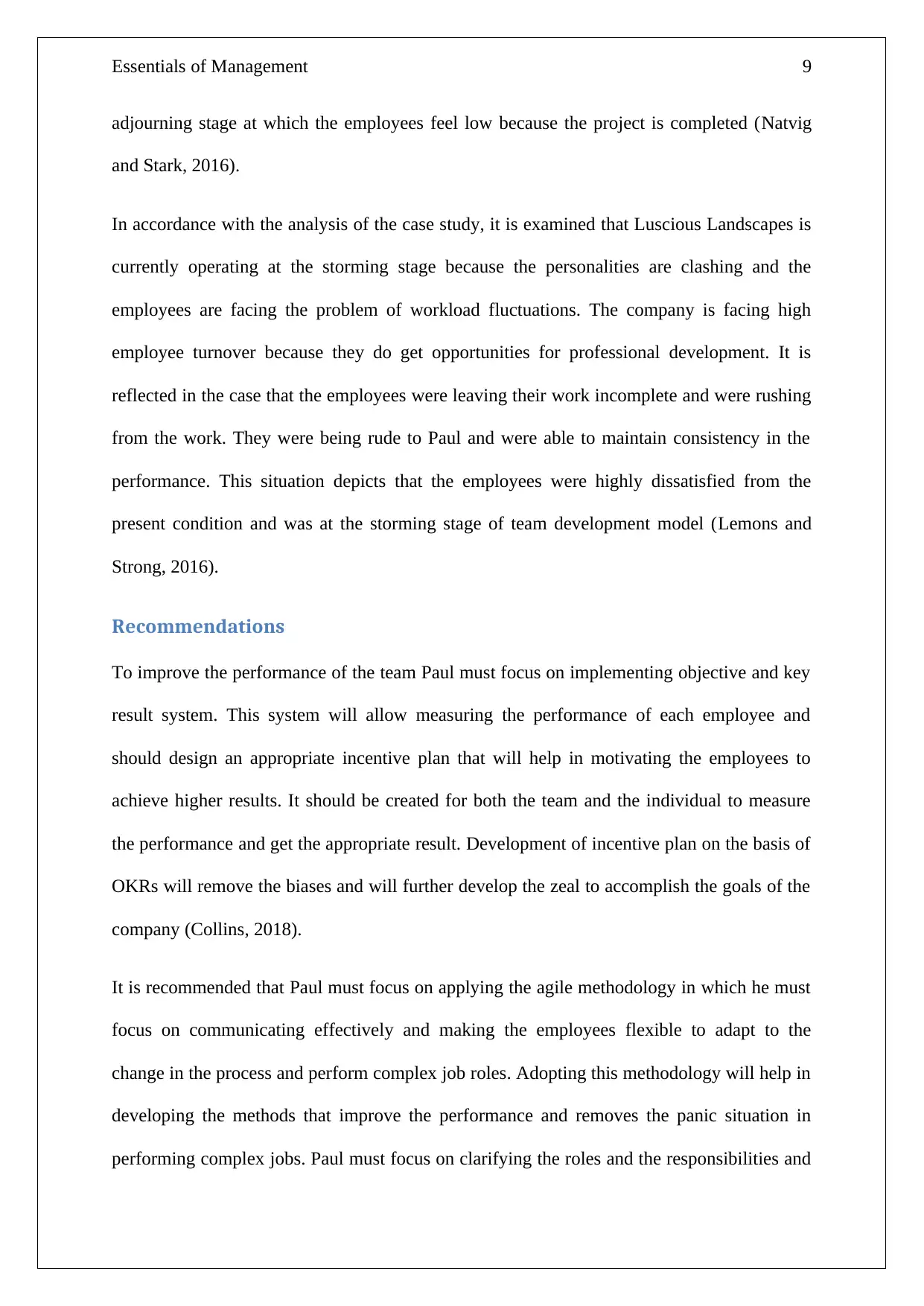
Essentials of Management 9
adjourning stage at which the employees feel low because the project is completed (Natvig
and Stark, 2016).
In accordance with the analysis of the case study, it is examined that Luscious Landscapes is
currently operating at the storming stage because the personalities are clashing and the
employees are facing the problem of workload fluctuations. The company is facing high
employee turnover because they do get opportunities for professional development. It is
reflected in the case that the employees were leaving their work incomplete and were rushing
from the work. They were being rude to Paul and were able to maintain consistency in the
performance. This situation depicts that the employees were highly dissatisfied from the
present condition and was at the storming stage of team development model (Lemons and
Strong, 2016).
Recommendations
To improve the performance of the team Paul must focus on implementing objective and key
result system. This system will allow measuring the performance of each employee and
should design an appropriate incentive plan that will help in motivating the employees to
achieve higher results. It should be created for both the team and the individual to measure
the performance and get the appropriate result. Development of incentive plan on the basis of
OKRs will remove the biases and will further develop the zeal to accomplish the goals of the
company (Collins, 2018).
It is recommended that Paul must focus on applying the agile methodology in which he must
focus on communicating effectively and making the employees flexible to adapt to the
change in the process and perform complex job roles. Adopting this methodology will help in
developing the methods that improve the performance and removes the panic situation in
performing complex jobs. Paul must focus on clarifying the roles and the responsibilities and
adjourning stage at which the employees feel low because the project is completed (Natvig
and Stark, 2016).
In accordance with the analysis of the case study, it is examined that Luscious Landscapes is
currently operating at the storming stage because the personalities are clashing and the
employees are facing the problem of workload fluctuations. The company is facing high
employee turnover because they do get opportunities for professional development. It is
reflected in the case that the employees were leaving their work incomplete and were rushing
from the work. They were being rude to Paul and were able to maintain consistency in the
performance. This situation depicts that the employees were highly dissatisfied from the
present condition and was at the storming stage of team development model (Lemons and
Strong, 2016).
Recommendations
To improve the performance of the team Paul must focus on implementing objective and key
result system. This system will allow measuring the performance of each employee and
should design an appropriate incentive plan that will help in motivating the employees to
achieve higher results. It should be created for both the team and the individual to measure
the performance and get the appropriate result. Development of incentive plan on the basis of
OKRs will remove the biases and will further develop the zeal to accomplish the goals of the
company (Collins, 2018).
It is recommended that Paul must focus on applying the agile methodology in which he must
focus on communicating effectively and making the employees flexible to adapt to the
change in the process and perform complex job roles. Adopting this methodology will help in
developing the methods that improve the performance and removes the panic situation in
performing complex jobs. Paul must focus on clarifying the roles and the responsibilities and
Paraphrase This Document
Need a fresh take? Get an instant paraphrase of this document with our AI Paraphraser
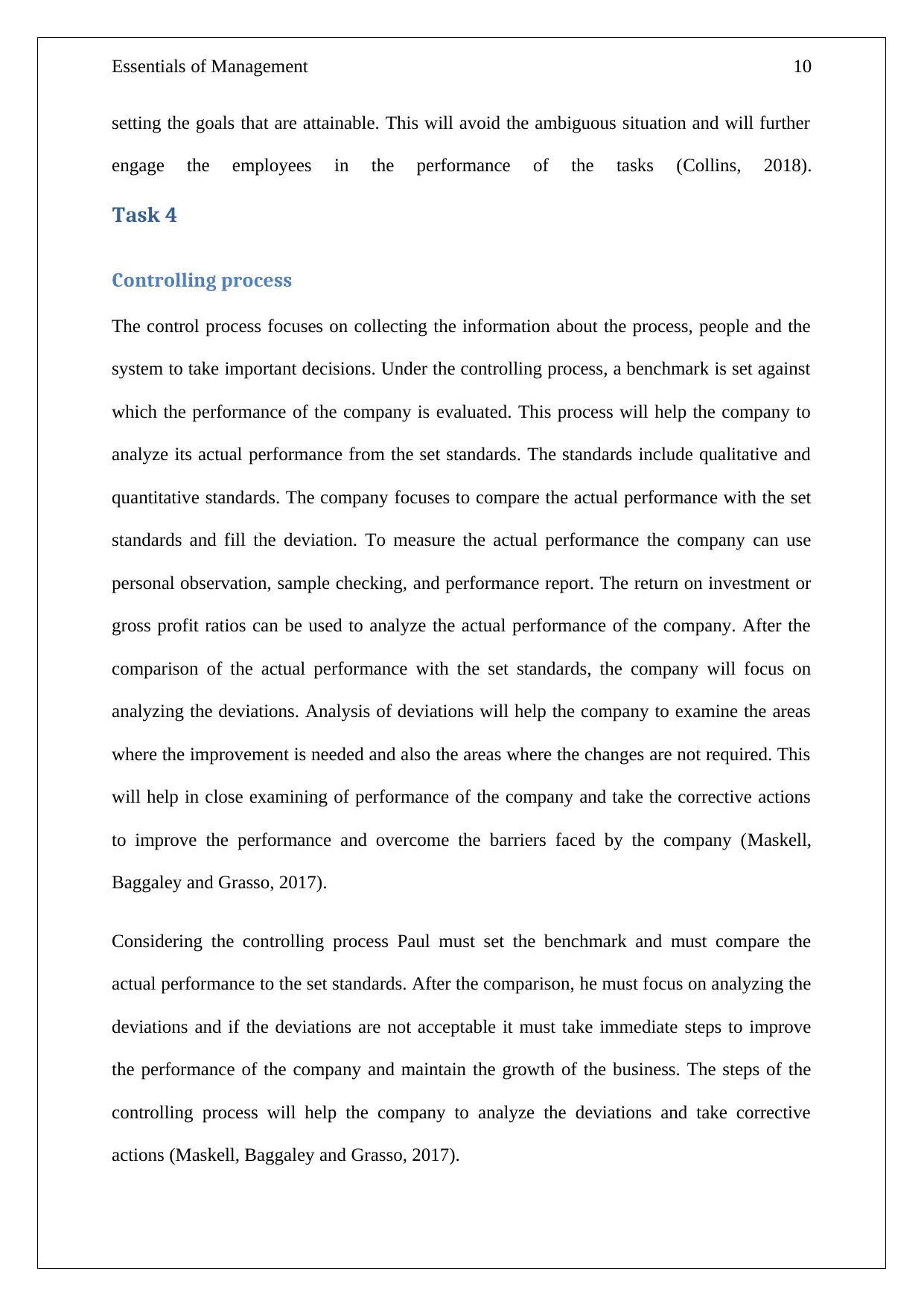
Essentials of Management 10
setting the goals that are attainable. This will avoid the ambiguous situation and will further
engage the employees in the performance of the tasks (Collins, 2018).
Task 4
Controlling process
The control process focuses on collecting the information about the process, people and the
system to take important decisions. Under the controlling process, a benchmark is set against
which the performance of the company is evaluated. This process will help the company to
analyze its actual performance from the set standards. The standards include qualitative and
quantitative standards. The company focuses to compare the actual performance with the set
standards and fill the deviation. To measure the actual performance the company can use
personal observation, sample checking, and performance report. The return on investment or
gross profit ratios can be used to analyze the actual performance of the company. After the
comparison of the actual performance with the set standards, the company will focus on
analyzing the deviations. Analysis of deviations will help the company to examine the areas
where the improvement is needed and also the areas where the changes are not required. This
will help in close examining of performance of the company and take the corrective actions
to improve the performance and overcome the barriers faced by the company (Maskell,
Baggaley and Grasso, 2017).
Considering the controlling process Paul must set the benchmark and must compare the
actual performance to the set standards. After the comparison, he must focus on analyzing the
deviations and if the deviations are not acceptable it must take immediate steps to improve
the performance of the company and maintain the growth of the business. The steps of the
controlling process will help the company to analyze the deviations and take corrective
actions (Maskell, Baggaley and Grasso, 2017).
setting the goals that are attainable. This will avoid the ambiguous situation and will further
engage the employees in the performance of the tasks (Collins, 2018).
Task 4
Controlling process
The control process focuses on collecting the information about the process, people and the
system to take important decisions. Under the controlling process, a benchmark is set against
which the performance of the company is evaluated. This process will help the company to
analyze its actual performance from the set standards. The standards include qualitative and
quantitative standards. The company focuses to compare the actual performance with the set
standards and fill the deviation. To measure the actual performance the company can use
personal observation, sample checking, and performance report. The return on investment or
gross profit ratios can be used to analyze the actual performance of the company. After the
comparison of the actual performance with the set standards, the company will focus on
analyzing the deviations. Analysis of deviations will help the company to examine the areas
where the improvement is needed and also the areas where the changes are not required. This
will help in close examining of performance of the company and take the corrective actions
to improve the performance and overcome the barriers faced by the company (Maskell,
Baggaley and Grasso, 2017).
Considering the controlling process Paul must set the benchmark and must compare the
actual performance to the set standards. After the comparison, he must focus on analyzing the
deviations and if the deviations are not acceptable it must take immediate steps to improve
the performance of the company and maintain the growth of the business. The steps of the
controlling process will help the company to analyze the deviations and take corrective
actions (Maskell, Baggaley and Grasso, 2017).
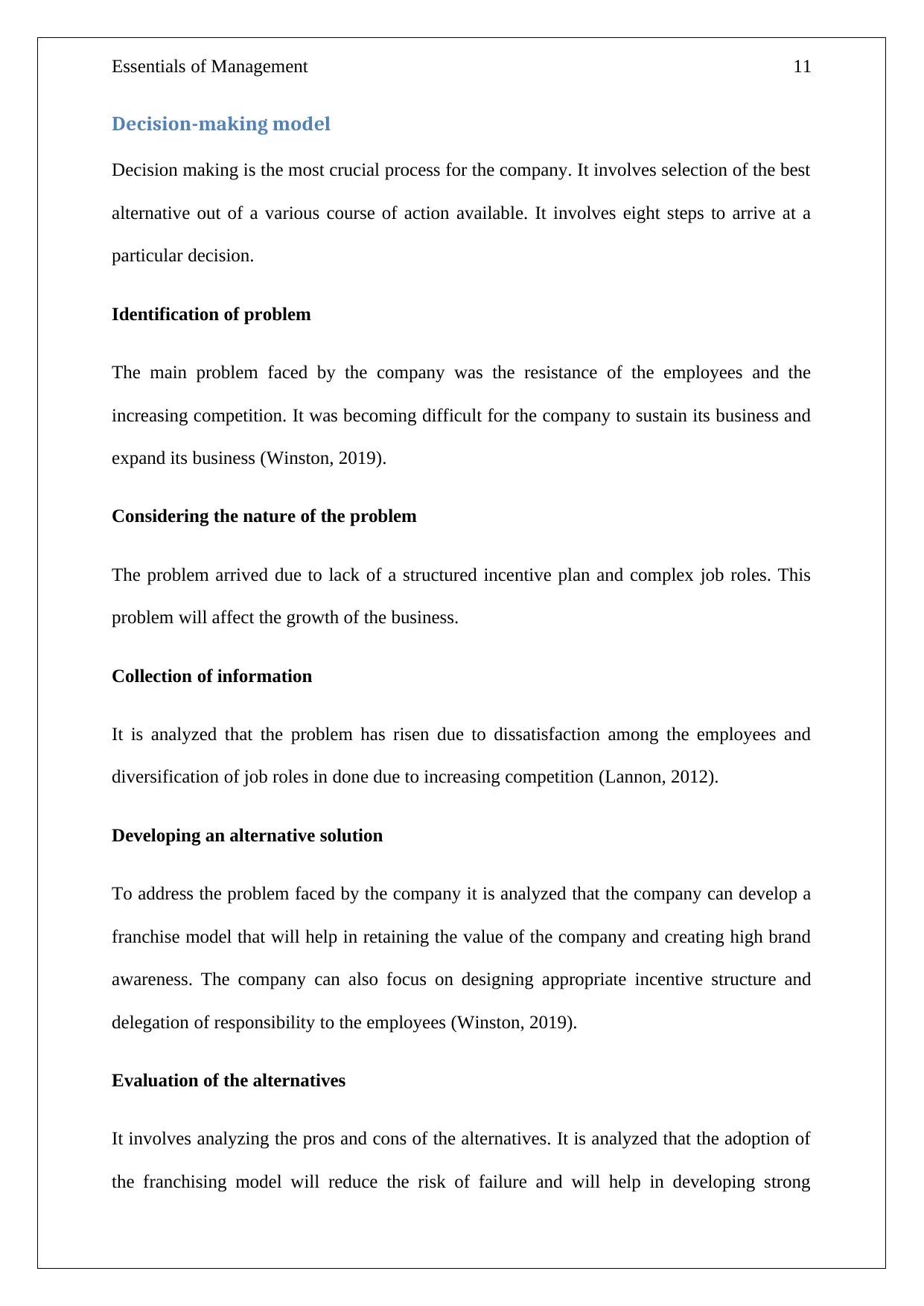
Essentials of Management 11
Decision-making model
Decision making is the most crucial process for the company. It involves selection of the best
alternative out of a various course of action available. It involves eight steps to arrive at a
particular decision.
Identification of problem
The main problem faced by the company was the resistance of the employees and the
increasing competition. It was becoming difficult for the company to sustain its business and
expand its business (Winston, 2019).
Considering the nature of the problem
The problem arrived due to lack of a structured incentive plan and complex job roles. This
problem will affect the growth of the business.
Collection of information
It is analyzed that the problem has risen due to dissatisfaction among the employees and
diversification of job roles in done due to increasing competition (Lannon, 2012).
Developing an alternative solution
To address the problem faced by the company it is analyzed that the company can develop a
franchise model that will help in retaining the value of the company and creating high brand
awareness. The company can also focus on designing appropriate incentive structure and
delegation of responsibility to the employees (Winston, 2019).
Evaluation of the alternatives
It involves analyzing the pros and cons of the alternatives. It is analyzed that the adoption of
the franchising model will reduce the risk of failure and will help in developing strong
Decision-making model
Decision making is the most crucial process for the company. It involves selection of the best
alternative out of a various course of action available. It involves eight steps to arrive at a
particular decision.
Identification of problem
The main problem faced by the company was the resistance of the employees and the
increasing competition. It was becoming difficult for the company to sustain its business and
expand its business (Winston, 2019).
Considering the nature of the problem
The problem arrived due to lack of a structured incentive plan and complex job roles. This
problem will affect the growth of the business.
Collection of information
It is analyzed that the problem has risen due to dissatisfaction among the employees and
diversification of job roles in done due to increasing competition (Lannon, 2012).
Developing an alternative solution
To address the problem faced by the company it is analyzed that the company can develop a
franchise model that will help in retaining the value of the company and creating high brand
awareness. The company can also focus on designing appropriate incentive structure and
delegation of responsibility to the employees (Winston, 2019).
Evaluation of the alternatives
It involves analyzing the pros and cons of the alternatives. It is analyzed that the adoption of
the franchising model will reduce the risk of failure and will help in developing strong
⊘ This is a preview!⊘
Do you want full access?
Subscribe today to unlock all pages.

Trusted by 1+ million students worldwide
1 out of 16
Related Documents
Your All-in-One AI-Powered Toolkit for Academic Success.
+13062052269
info@desklib.com
Available 24*7 on WhatsApp / Email
![[object Object]](/_next/static/media/star-bottom.7253800d.svg)
Unlock your academic potential
Copyright © 2020–2025 A2Z Services. All Rights Reserved. Developed and managed by ZUCOL.





